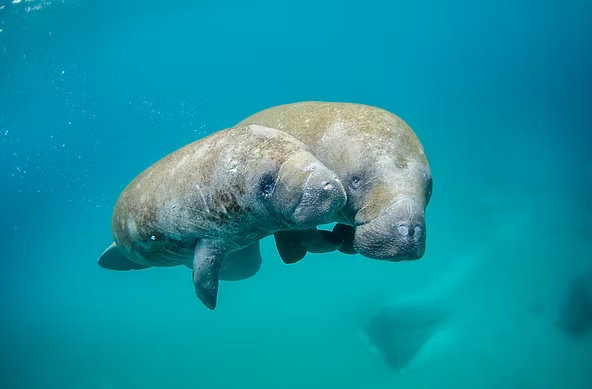West Indian Manatee: Gentle Giants of the Sea
The West Indian manatee is one of three living manatee species and belongs to the larger sea cow family, which also includes the dugong. These peaceful marine mammals inhabit the warm waters of the western Atlantic Ocean. While they primarily live in shallow coastal seas, they occasionally venture into freshwater springs, especially during colder winter months.
Diet and Behavior
Entirely herbivorous, the West Indian manatee spends much of its time grazing in seagrass beds. Using their strong, flexible lips, they pull seagrass from soft sediments. With no need for complex hunting strategies, their brains are small relative to their large body size. An adult can weigh up to 1,200 pounds (544 kg), reach 10 feet (3 m) in length, and consume as much as 150 pounds of vegetation per day—roughly 15 percent of its body weight.
Life Cycle
Like all mammals, manatees reproduce through internal fertilization. Mothers give birth to large calves, which nurse and remain with them for up to two years before becoming more independent. While adults have no natural predators, young calves may fall prey to large coastal sharks. Manatees are slow, gentle swimmers, averaging 3–5 miles per hour (4.8–8 km/h), and spend up to half their day sleeping.
Migration and Habitat
West Indian manatees require warm water to survive. They migrate seasonally, moving between productive summer feeding grounds and warmer wintering areas. These include tropical seas, natural warm springs, and even artificial warm-water outflows near power plants. Exposure to water colder than 68°F (20°C) can be fatal, making migration critical for survival.
Subspecies
There are two recognized subspecies: the Florida manatee (Trichechus manatus latirostris) and the Antillean manatee (Trichechus manatus manatus). The other two manatee species live in Brazil and Africa, making the West Indian manatee the most widespread of its kind.
Conservation Status
Though legally protected across much of its range, West Indian manatees remain vulnerable. Major threats include habitat destruction, hunting, accidental entanglement in fishing gear, and most significantly, collisions with boats. Because manatees are slow-moving and often swim near the surface, they are highly susceptible to boat strikes, especially in popular recreational areas. Populations have declined in certain regions and are regionally extinct in others. The species is currently classified as vulnerable to extinction, underscoring the need for continued conservation efforts.
Fun Facts
- They can hold their breath for up to 20 minutes but typically surface every few minutes.
- They migrate to warmer waters during winter to avoid deadly cold stress.
- Despite their size, they are gentle and curious creatures, sometimes nicknamed “sea cows.”

